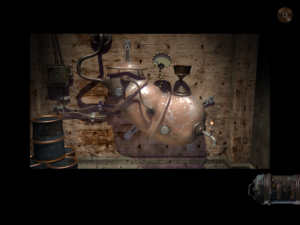Bioscopia: Symbols and Learning
Since my last post, I’ve started making progress again, mainly by revisiting places a lot to see if I noticed anything new. If nothing else, wandering in this way exposes the player to more “educational” content: in order to keep using doors, you have to periodically recharge your keycard by playing biology trivia at the card-recharging stations located in each major section, conveniently near the “big brain” machines that give you access to the in-game textbook containing all the answers.
The keycard turned out to be the key to my earlier stuckness, as it turned out that my initial low-clearance one could open two doors from the hub, not just one as I had believed. I could have sworn I had tried it on all of the doors, but I guess not. And by now, I have a superior card that lets me through any door with a slot. Not that all doors have slots. There are still puzzles to solve.
 One of the first things I found this time around was an outsized organ attached to a wall, with an intake funnel and an outflow valve, like something out of a Fritz Kahn illustration. I’m not sure what organ it’s supposed to be — to me, it looks like a pancreas more than anything else, but that doesn’t fit the plumbing. At any rate, it was clearly a new type of puzzle: one based on interacting with biological mechanisms rather than just displaying knowledge of them. Mentally squinting, I think I can make out some less-obvious examples of this in the architecture, situations that are symbols of the processes that I’m supposed to be learning about, like how the circuitous entry into the inner part of the microbiology lab reflects the way a carrier protein transports a molecule through a cell membrane.
One of the first things I found this time around was an outsized organ attached to a wall, with an intake funnel and an outflow valve, like something out of a Fritz Kahn illustration. I’m not sure what organ it’s supposed to be — to me, it looks like a pancreas more than anything else, but that doesn’t fit the plumbing. At any rate, it was clearly a new type of puzzle: one based on interacting with biological mechanisms rather than just displaying knowledge of them. Mentally squinting, I think I can make out some less-obvious examples of this in the architecture, situations that are symbols of the processes that I’m supposed to be learning about, like how the circuitous entry into the inner part of the microbiology lab reflects the way a carrier protein transports a molecule through a cell membrane.
This sort of architectural symbolism was found abundantly in Chemicus, where the whole layout of the game was an imitation of the periodic table of elements (with the noble gases only accessible through a secret passage, indicating their resistance to ordinary connections). I suppose Bioscopia‘s overall layout similarly resembles a cell, with the inaccessible tree in the middle representing the nucleus. I’ve been assuming that crossing that chasm is the passage into the endgame, which means symbolically, what, impregnating the compound? Virally infecting it? The ultimate goal of the game is to rid the place of an infection, a plague contracted by the previous tenants.
At any rate, the organ on the wall is one of the few cases of the game attempting to teach through an approximation to what Ian Bogost calls “procedural rhetoric” — that is, instead of presenting the audience with a statement directly, presenting a rule-based system that embodies the statement and letting the audience discover it by interacting with the system. It’s not a very advanced example of this technique, though, and it pretty decisively fails at its pedagogical purpose: I interacted with it, I solved the puzzle it was part of, and I still don’t know what I was supposed to learn.
 Comments(0)
Comments(0)